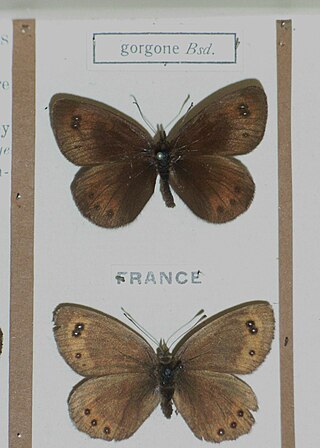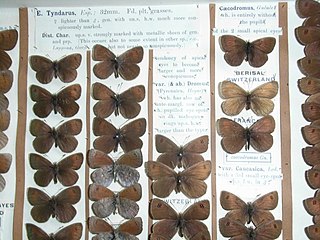
The small mountain ringlet or mountain ringlet is a butterfly of the family Nymphalidae. It is found in mountainous regions of southern and central Europe.

Erebiola butleri, or Butler's ringlet, is an elusive New Zealand endemic butterfly, discovered in 1879 by John Enys at the alpine pass at the head of the Rakaia River. It is the only member of the genus Erebiola.

Erebia is a Holarctic genus of brush-footed butterflies, family Nymphalidae. Most of the about 90–100 species are dark brown or black in color, with reddish-brown to orange or more rarely yellowish wing blotches or bands. These usually bear black spots within, which sometimes have white center spots.

Erebia euryale, the large ringlet, is a species of butterfly belonging to the family Nymphalidae.

Erebia alberganus, the almond ringlet or almond-eyed ringlet, is a butterfly of the family Nymphalidae.

Erebia ligea, the Arran brown, is a member of the subfamily Satyrinae of the family Nymphalidae. This brown is widespread in south-eastern and northern Europe. It prefers mixed woodlands at low altitudes. It is rarely seen in open areas. This species was first described by Carl Linnaeus in his 1758 10th edition of Systema Naturae, and the type locality is Sweden.

Erebia tyndarus, the Swiss brassy ringlet, is a European brush-footed butterfly species of the subfamily Satyrinae.

The de Prunner's ringlet is a member of the subfamily Satyrinae of the family Nymphalidae.

The Gavarnie ringlet is a member of the subfamily Satyrinae of the family Nymphalidae. It is a high-altitude butterfly found in France and Spain, notably at Cirque de Gavarnie in the Pyrenees National Park.

Erebia lefebvrei, or Lefèbvre's ringlet, is a member of the subfamily Satyridae of the family Nymphalidae. This brown is found in France. It has been considered a subspecies of Erebia melas.

The brassy ringlets are a species group of ringlet butterflies in the genus Erebia. Though closely related, their monophyly is not completely resolved. Still, the brassy ringlets are taxa similar to E. tyndarus – the Swiss brassy ringlet –, and in many cases certainly close relatives. A notable trait of their genus is an ability to adapt well to cold and somewhat arid habitat, like taiga or regions with alpine climate. Optimal habitat in Eurasia, where most of the brassy ringlets are found, therefore occurs in two distinct belts – in the very north of the continent and in the Alpide belt – in interglacials, and in glacials in one periglacialic belt at lower altitude, in places interrupted by dry wasteland and deserts.

Erebia nivalis, or de Lesse's brassy ringlet, is a member of the subfamily Satyrinae of the family Nymphalidae. It is found throughout the Alps of southern Austria with a remote population in central Switzerland.

Erebia cassioides, the common brassy ringlet, is a member of the subfamily Satyrinae of family Nymphalidae.

Erebia callias, the Colorado alpine, is a member of the Satyridae subfamily of the Nymphalidae butterflies. It is found in alpine areas of Wyoming and Colorado in the U.S. Rocky Mountains as well as various mountain ranges in eastern Asia.

Montes Universales is a 32 km (20 mi) long mountain range in the southeastern end of the Iberian System. Its highest point is the 1,935 m high summit known as Caimodorro. The 1,830 m high Muela de San Juan is another important peak.
Erebia polaris, the Arctic woodland ringlet, is a butterfly of the family Nymphalidae. It is found in Lapland and boreal Asia.

Erebia calcaria, or Lorkovic's brassy ringlet, is a butterfly of the family Nymphalidae. It is found in the Alps. The species inhabits southern exposed slopes with alpine grassland interspersed with rocks. Screes without vegetation or only a few grass tussocks cannot serve as habitat.

Erebia rondoui, the Pyrenees brassy ringlet, is a species of butterfly in the family Nymphalidae. It is found in France and Spain, where it is endemic to altitudes ranging from 1,650 to 2,300 meters above sea level in the Pyrenees.


















